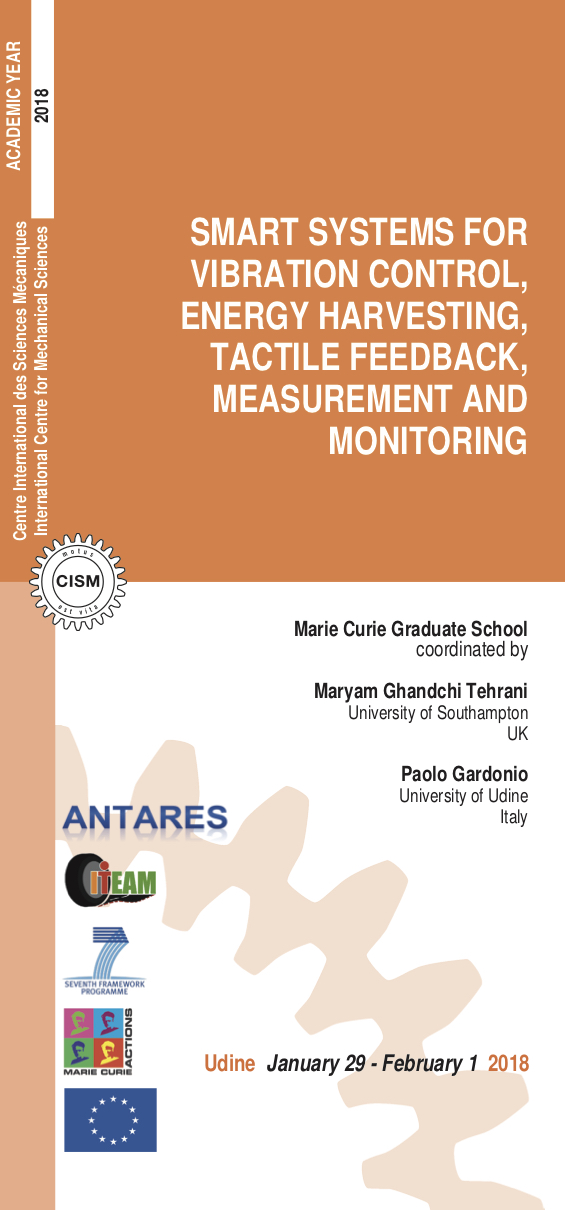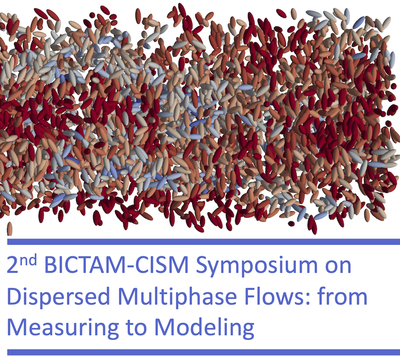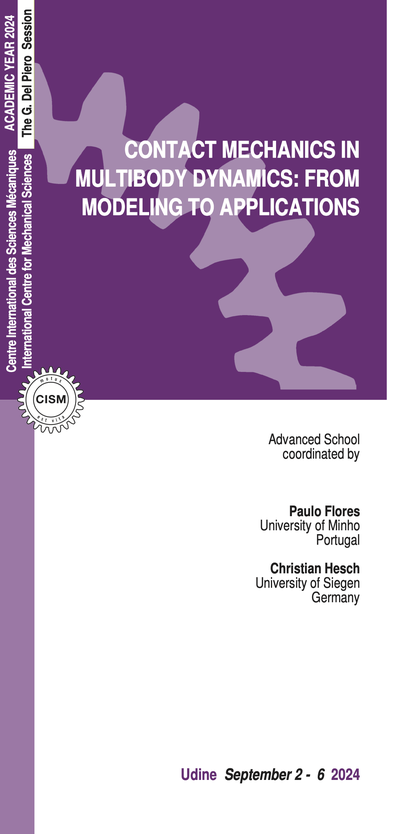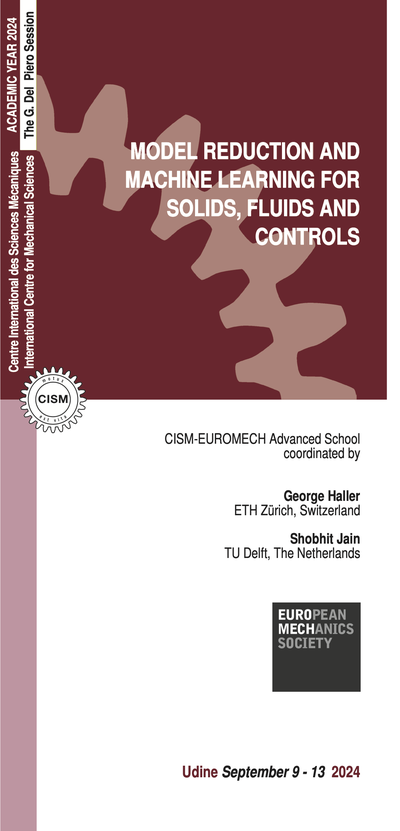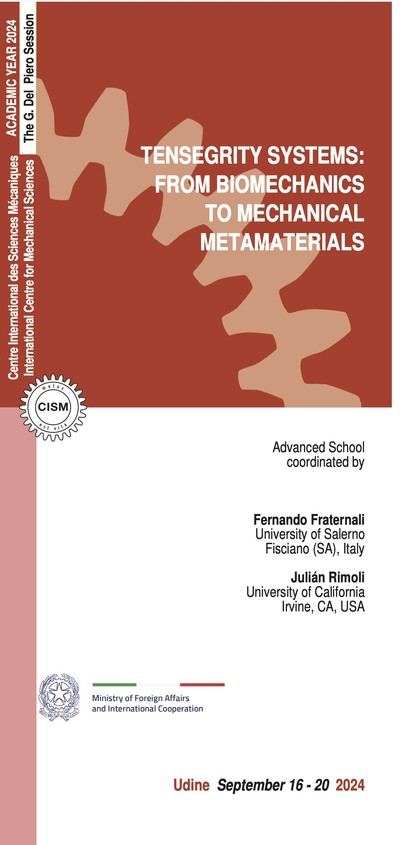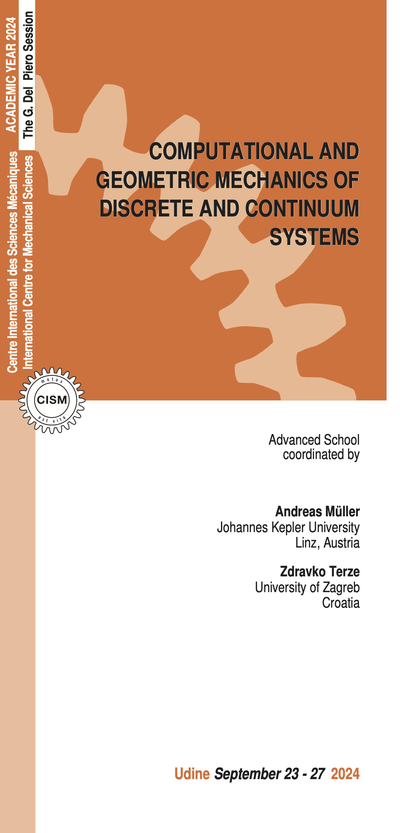The CISM – Marie Curie Graduate School on Smart Systems for Vibration Control, Energy Harvesting, Tactile Feedback and Condition Monitoring brings together expert lecturers in the fields of vibration control, transducers and materials, control theory, signal processing, electronics and energy harvesting. The course combines academic scientific excellence with industrially-relevant applications and is organized by the partners of the on-going intersectorial EU FP7 Marie Curie Training Network project ITN ANTARES – focussing on Energy Efficient Smart Structures, and the EU H2020 Marie Sklodowska Curie Training Network project ETN ITEAM – focussing on Multi-Actuated Ground Vehicles – .
The first part, concerns Smart Systems for Vibration Control. Active control is used to attenuate undesirable disturbances by introducing secondary sources, whose outputs interfere with the primary disturbance destructively. Techniques for modelling and analysis of active control of sound and vibration problems will be presented. There are two strategies for active vibration control: feedforward and feedback. Feedforward is mainly used to control tonal vibrations and requires a reference signal correlated to the primary disturbance. Feedback control is widely used for broadband disturbances. In this case error sensors are employed to detect the unwanted vibrations. The measured signals are fed back to the control actuators via classical decentralised controllers or multi-channel “modern” controllers. The differences between the two control strategies in terms of performance and stability robustness will be explained. The fundamentals of vibration isolation using passive, semi-active and active control will be discussed. The multivariable feedback control will be covered. Multi-channel feedforward control systems can be achieved using least-mean-square (LMS) algorithms. Properties of the LMS algorithm such as the convergence will be explained. To prevent the control effort from being large, a cost function, which includes an effort term, can be added to the error cost function. Nonlinear control strategies will be presented both in time and frequency domains to take into account the effect of nonlinearities both in the structure and in the controller. A Receptance method is presented based on the concept of the describing function to assign the poles of the system to desired locations in the complex plane. Active vibration control of systems with periodic time varying parameters (parametrically excited systems) will be demonstrated. The feasibility of active control will be demonstrated for a variety of industrial applications.
The second part, is focussed on Smart Systems for Vibration Energy Harvesting. These systems provide tiny quantities of power going from the order of milli-watts, for devices smaller than 1 kg, to the order of watts, for devices larger than 1 kg. Several applications have been explored over the years; For example, vibration energy harvesting devices have been implanted on the human body to power medical devices. Clothes have been equipped with smart piezoelectric films to power low-energy electronic apparatuses. Vibration energy harvesting systems have been mounted on buildings, transportation vehicles and industrial machinery to run condition monitoring devices. Smart vibration harvesting structures have been set in air or water flows to extract energy to power condition monitoring devices. The fundamentals of energy harvesting with electromagnetic and piezoelectric seismic transducers will be first discussed. To increase the dynamic range of energy harvesters, various damping arrangements will be suggested such as nonlinear damping, level-dependent damping and parametric impulsive damping. The conception and design of the harvesting electrical circuits will then be discussed. Also, experimental results will demonstrate how the dynamic performance range of energy harvesters can be extended using these arrangements. Finally considerations for the practical implementation of vibration energy harvesting will be provided. The design of vibration energy harvesting systems is not always straight forward; therefore a methodical design process for vibration energy harvesting systems will be revised. This process includes a) the estimation of the available vibration energy and its spectral and temporal characteristics, b) the design of the actual energy harvesting system and its key components, considering the vibration energy available, the electrical energy needed and other application specific requirements and c) operational and durability testing in the laboratory.
The third part, is focussed on Smart Systems for Vibration Tactile Feedback. The quality of today’s visual and acoustic interface requires improvement even on home and office computers. For instance haptic interaction is usually limited to the use of keyboard and mouse. Tactile displays can enable haptic perception of different virtual surface textures like textiles, leather, wood and plastics. Such tactile output devices have a wide range of possible applications. Besides entertainment industry and e-commerce, virtual prototype development and virtual training are also possible fields of application. Their use as feedback sensors in medical applications, automotive and machine control as well as for sensory support of blind people is possible, too. A multitude of different mechanoreceptors in human fingers is responsible for tactile perception. Each type of receptor responds to particular stimuli and excitation frequencies. Some receptors are specialised in detecting skin shearing, others respond to deformations acting in normal direction to the skin. To be able to simulate tactile perception of surfaces as accurately as possible, various types of receptors have to be stimulated specifically. This part covers fundamentals of the development of tactile displays. This starts with the basics of tactile perception of humans and the identification of the requirements of display devices. The different kinematical concepts of tactile displays and the modeling of the active elements is then covered. Finally the operation and the self-sensing capabilities of the actuator elements within the display are revised and discussed in detail.
The fourth part, is focussed on Smart Systems for Vibration Measurement and Monitoring. First of all methods for estimation of a linear system are introduced for the cases where the inputs are unknown and derived from measured signals. As a practical example, the behaviour of a MIMO Kalman active control scheme in time-varying systems is then revised. A radical new way is then presented for the measurement of mechanical quantities difficult to assess in practice, such as power, force, energy flow, etc. This new approach exploits a priori known information of the system and blends this information in the form of physical first-principle models with experimental data. As such, “cheap” and “easy” measurements are enriched with model data providing high added value information for monitoring, control and other purposes. Vibration signals are among the most important information-carrying data. Thus, novel signal processing techniques, which have been developed to extract information on individual components of complex systems, will be presented. Those methodologies are combined with machine learning approaches focusing towards monitoring of complex systems and processes in the era of Internet of Things (IoT) and Digital Factory. The practical implementation of two special measurement systems will be finally revised. The first deals with the application of a SISO and MIMO feedback control for environmental testing, in which a test article is exposed to a vibration and acoustic environment that replicates real operational conditions. For example, these tests are used to demonstrate that a satellite will survive its launch, or that automotive components will not fail when driving the car over a rough road. The second is focussed on the implementation of a smart and autonomous condition monitoring system for vibration, stress, fatigue and failure analysis, which constitutes the main basis for the validation of structural health monitoring applications.
The Graduate School is organised within the technical programme of the International Centre for Mechanical Sciences (CISM) and is held at CISM premises. The school provides technical training for both Early Stage and Experienced Researchers and creates a platform for networking and knowledge exchange.
The European Commission is gratefully acknowledged for supporting the organisation of this training course through the FP7 Marie Curie project ITN ANTARES and the H2020 Marie Sklodowska Curie project ETN ITEAM.
Energy harvesting systems: Considerations for practical applications
Output-only and virtual sensor estimation
Transfer path tracking for vibroacoustic control
Virtual sensing using reduced order high fidelity models
Active-Semi Active Vibration Isolation Part I
Active-Semi Active Vibration Isolation Part II
Multi-variable control
Multi-Channel feed-forward Vibration Control
Nonlinear velocity feedback for dynamic range control
Autonomous Smart Systems for Vibration Measurements
Transducers for vibration energy harvesting
Piezoelectric and electromagnetic seismic harvesters
Active vibration control of time-varying and nonlinear systems<
Nonlinear and parametric energy harvesters: Application to trains
Vibration based condition monitoring of complex mechanical systems
Methodical design of vibration energy harvesting systems
Vibration (and acoustic) control for environmental testing
Electronic circuits for vibration energy harvesting
Fundamentals on Human Tactile Impressions
Model-based and experimental identification of interface properties
Concepts and Design of Tactile Displays
Modeling of piezoelectric elements utilizing the transfer matrix method
Self-sensing in piezoelectric elements
Optimization of piezoelectric elements for applications in tactile displays
The registration fee is 340.00 Euro + VAT taxes*, where applicable (bank charges are not included).
The registration fee includes a complimentary bag, three fixed menu buffet lunches, coffee breaks, printed lecture notes, downloadable lecture notes and wi-fi internet access.
Applicants must apply by January 24, 2018.Applications should be made on-line through our web site: http://www.cism.it/courses/J1801/.
A message of confirmation will be sent to accepted partici-pants.Information about travel and accommodation is available on our web site, or can be mailed upon request.
A limited number of rooms is available at our Guest House at the rate of Euro 30,00 per person/night.
Applicants may cancel their course registration and receive a full refund by notifying CISM Secretariat in writing (by email) no later than two weeks prior to the start of the course.
If cancellation occurs less than two weeks prior to the start of the course, a Euro 50,00 handling fee will be charged.Incorrect payments are subject to Euro 50,00 handling fee.
